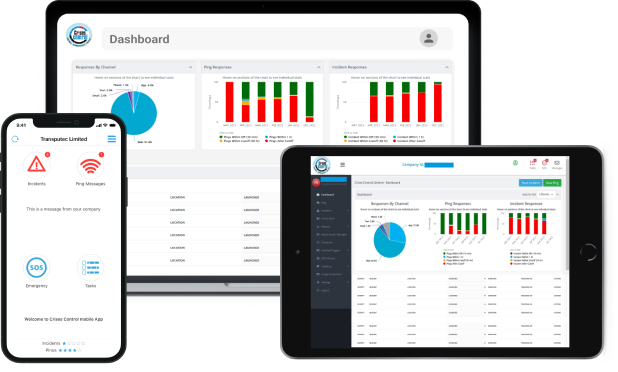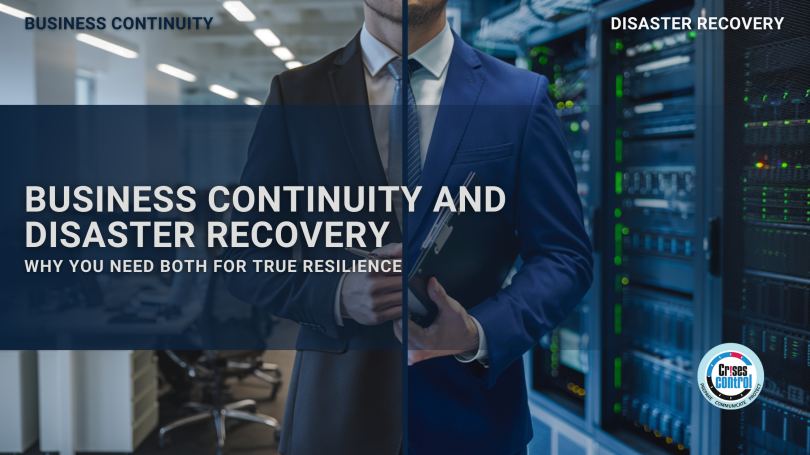Written by Anneri Fourie | Crises Control Executive
Unexpected disruptions can bring businesses to a standstill. Whether it’s a cyberattack, natural disaster, system failure, or even human error, organisations must be prepared to respond and recover, fast.
Many businesses assume that having either a business continuity plan or a disaster recovery strategy is enough. However, these two strategies serve different purposes. Business continuity focuses on keeping operations running during a crisis, while disaster recovery ensures that IT systems and data can be restored after a disruption.
Without a business continuity solution and disaster recovery software working together, businesses risk prolonged downtime, financial losses, and reputational damage.
In this blog, we’ll break down the differences between business continuity and disaster recovery, why businesses need both, and how Crises Control helps organisations build a complete resilience strategy.
What is Business Continuity?
Business continuity is about keeping the organisation running during a crisis. It’s a proactive approach, meaning businesses prepare in advance to reduce disruptions, protect employees, and maintain essential operations.
A business continuity solution helps companies put structured plans in place, so when an incident occurs, there is a clear process to follow.
Key Components of a Business Continuity Plan
- Risk Assessment & Business Impact Analysis (BIA)
- Identify potential threats (cyberattacks, supply chain disruptions, power failures).
- Assess how these threats could impact critical business functions.
- Emergency Communication & Mass Notification
- Ensure employees and stakeholders receive real-time alerts.
- Use multiple channels (SMS, email, push notifications) to reach people instantly.
- Incident Response & Crisis Management
- Define clear steps for responding to different types of disruptions.
- Assign roles and responsibilities for an efficient response.
- Workforce & Operational Resilience
- Enable remote work or backup work locations.
- Ensure critical functions can continue even if the main office is inaccessible.
- Regular Testing & Simulation Exercises
- Conduct drills to test response plans.
- Identify gaps and improve processes before a real crisis occurs.
How Crises Control Strengthens Business Continuity
Crises Control provides a business continuity management solution that ensures organisations can act quickly and stay in control during a crisis.
- Cloud-Based Business Continuity Planning: Access plans anytime, from anywhere.
- Mass Notification System: Instantly alert employees, customers, and stakeholders.
- Automated Task Management: Assign and track response actions.
- Incident Plan Builder: Create structured, step-by-step crisis response plans.
With Crises Control, businesses can minimise disruptions, keep operations running, and protect their people.
What is Disaster Recovery?
Disaster recovery focuses on restoring IT systems, data, and infrastructure after a disruption. It’s a reactive strategy that ensures businesses can recover quickly after an incident.
While business continuity keeps things running, disaster recovery software ensures that lost data, applications, and systems are restored with minimal downtime.
Key Components of a Disaster Recovery Plan
- Data Backup & Storage Solutions
- Regularly backup critical data to prevent permanent loss.
- Store backups in secure cloud environments.
- Failover & Redundancy
- Implement backup servers and cloud solutions to take over if the primary system fails.
- Reduce downtime by switching to backup systems instantly.
- Cybersecurity & Ransomware Protection
- Protect IT infrastructure from cyberattacks.
- Ensure quick restoration of data if systems are compromised.
- Disaster Recovery Testing & Simulations
- Regularly test recovery strategies to ensure effectiveness.
- Reduce recovery time by refining processes based on test results.
- Recovery Time Objectives (RTO) & Recovery Point Objectives (RPO)
- Define how long systems can be down before it impacts the business.
- Set acceptable limits on data loss.
How Crises Control Supports Disaster Recovery
Crises Control provides disaster recovery software that ensures IT resilience and rapid recovery.
- Incident Management System: Coordinates disaster recovery efforts in real time.
- Secure Cloud Hosting: Protects critical data from cyber threats, system failures, and disasters.
- Audit & Compliance Reporting: Generates post-incident reports for regulatory compliance.
- Seamless IT Integration: Works with existing IT systems to enhance recovery capabilities.
With Crises Control, businesses can recover quickly, reduce financial losses, and protect critical data.
Business Continuity vs. Disaster Recovery: Key Differences
Many organisations confuse business continuity and disaster recovery or believe one is enough. However, both serve distinct purposes.
| Aspect | Business Continuity | Disaster Recovery |
|---|---|---|
| Approach | Proactive | Reactive |
| Objective | Maintain operations during a crisis | Restore IT systems after a crisis |
| Focus | People, processes, and communication | IT infrastructure and data |
| Timeframe | Before, during, and after a disruption | After a disruption |
| Tools Used | Mass notifications, task automation. Crisis planning | Data backup, failover solutions, cybersecurity |
Why You Need Both for a Resilient Business
Some businesses prioritise business continuity while neglecting disaster recovery, and vice versa. But without both, there are serious risks:
A Business Continuity Plan Without Disaster Recovery
- Keeps teams operational, but leaves IT systems vulnerable.
- Risk of data loss, cyberattacks, or system failures with no recovery plan.
A Disaster Recovery Plan Without Business Continuity
- Restores IT systems, but does not ensure employees and stakeholders can continue operations.
- Leads to confusion, delays, and financial losses while waiting for systems to come back online.
By integrating both strategies, organisations can create a complete resilience plan that ensures smooth operations during a crisis and rapid recovery after an incident.
How Crises Control Combines Business Continuity and Disaster Recovery
Crises Control bridges the gap between business continuity and disaster recovery with an all-in-one business continuity management solution that includes:
- Proactive Business Continuity Planning: Structured crisis response plans.
- Real-Time Incident Response & Recovery: Automated response actions and recovery procedures.
- Mass Notification System: Instant alerts to employees, customers, and stakeholders.
- Disaster Recovery Software: Secure cloud hosting and real-time monitoring for IT resilience.
- Compliance & Audit Reporting: Helping organisations meet regulatory requirements.
With Crises Control, businesses don’t have to choose between business continuity and disaster recovery, they get both in a single, easy-to-use platform.
Ensure Your Business is Ready for Any Crisis
Disruptions can happen at any time. Without a complete strategy that includes both business continuity and disaster recovery, businesses risk financial losses, reputational damage, and extended downtime.
A business continuity solution ensures operations continue, while disaster recovery software restores critical IT systems. Together, they create a resilient, prepared organisation that can withstand any crisis.
Crises Control provides a fully integrated business continuity management solution that covers both strategies, ensuring seamless crisis response and recovery.
Don’t wait for a crisis to test your resilience. Contact us today for a free personalised demo and see how Crises Control can protect your business.
Request a FREE Demo









